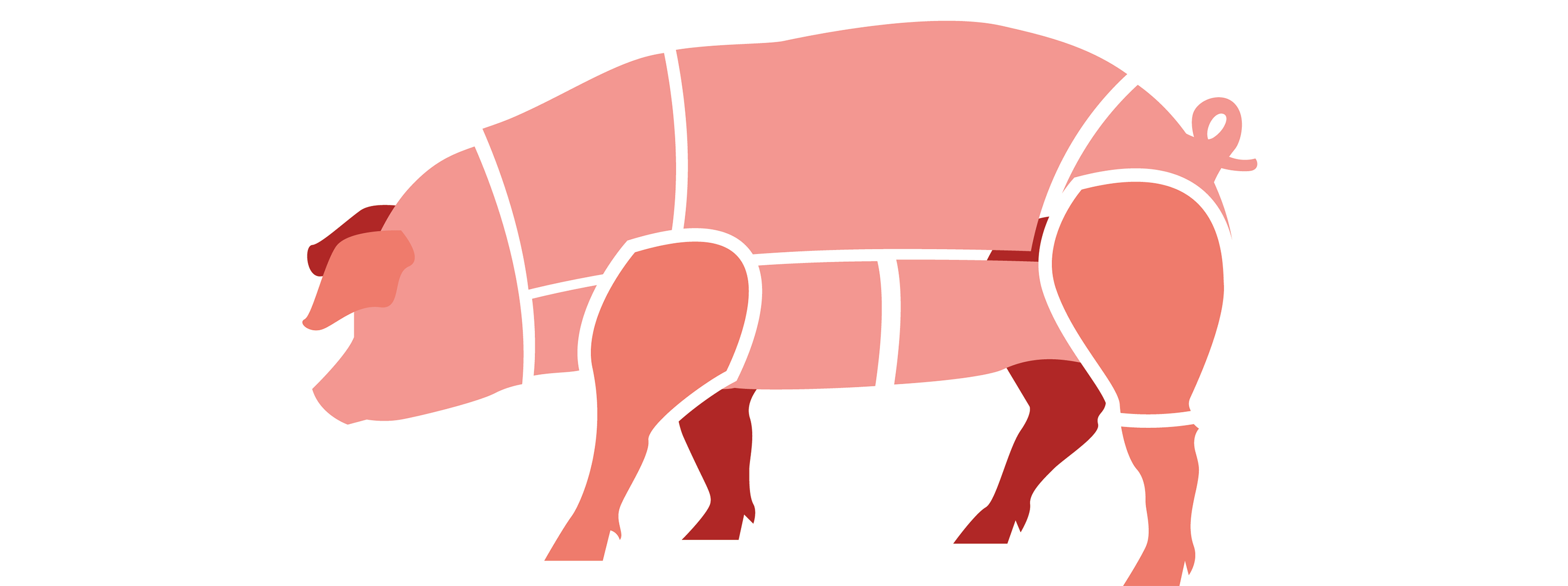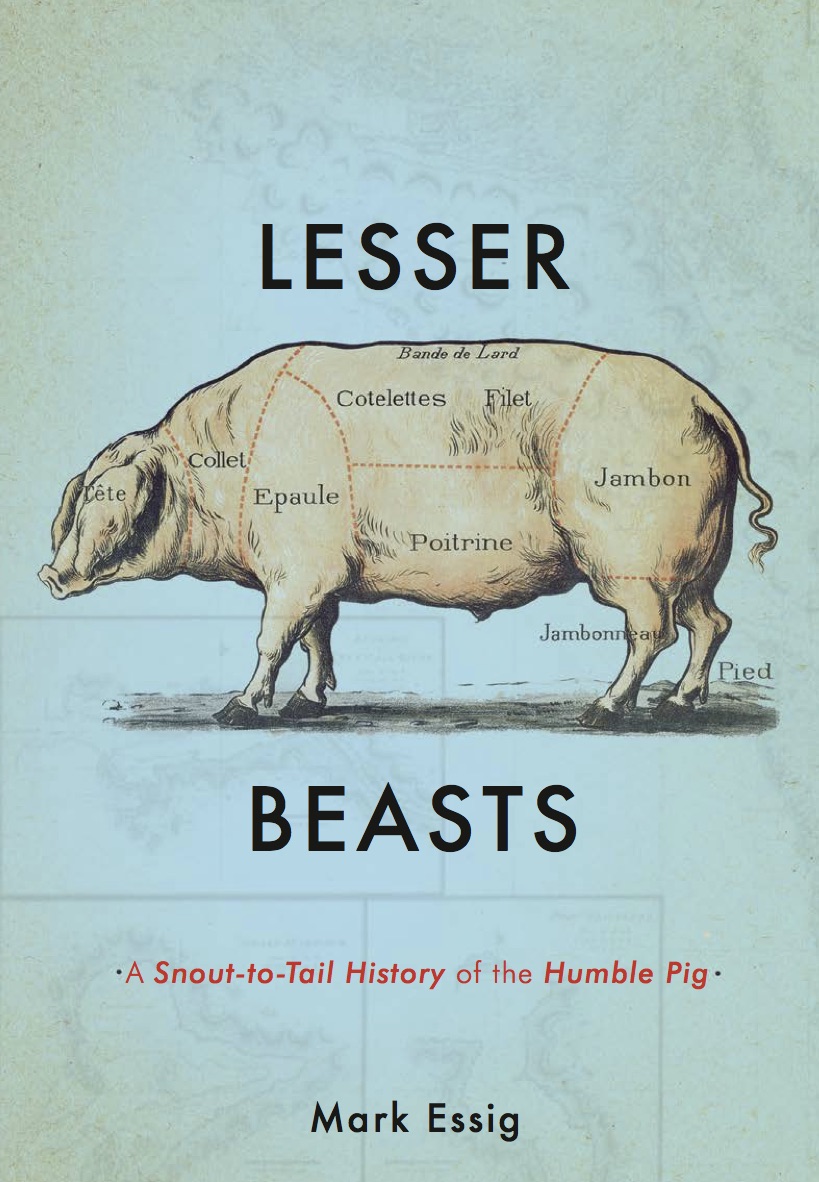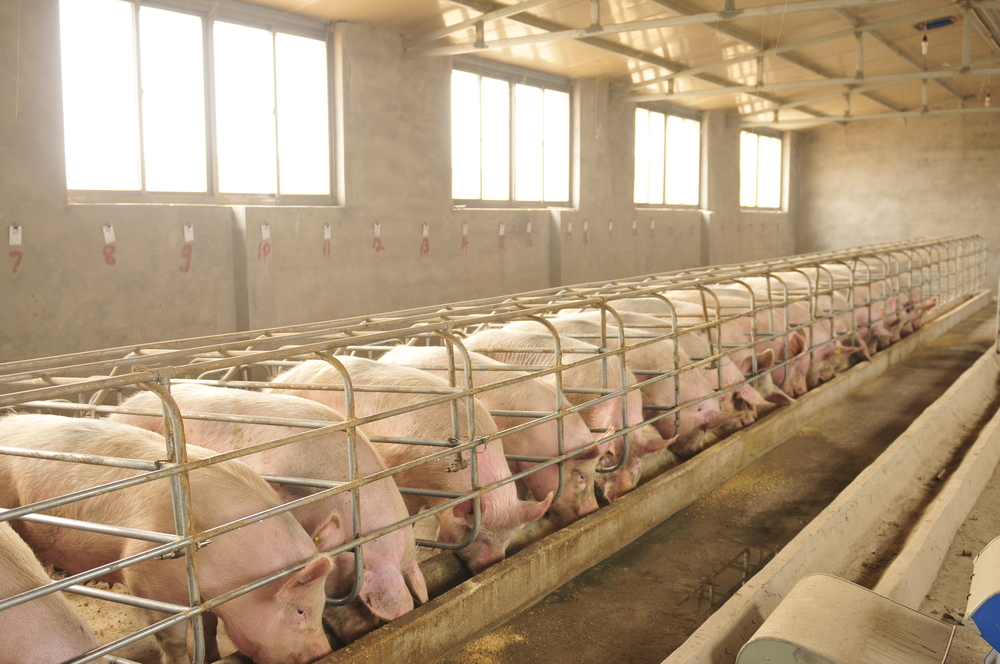
Mark Essig’s Lesser Beasts: A Snout to Tail History of the Humble Pig is an ambitious, free-ranging book. It draws not only on history, but also on anthropology, folklore, paleontology, archeology, sociology, contemporary food studies, and probably a dozen other disciplines to weave a compelling narrative that, while centered on the pig, explores less tangible, heavier stuff such as faith, taste, ethics, and status.
Essig, who holds a Ph.D. in history from Cornell University, chose to do something few professional historians do: write a book that’s both scholarly and accessible. Even more improbably, he pulled it off. What follows are Essig’s abridged answers to the big questions I had about his book.
The history of swine isn’t your garden-variety interest. What drew you to the topic?
Pig drives. Eight years ago I moved to Asheville, North Carolina, in the southern Appalachian Mountains, and I learned that, in the 19th century, tens of thousands of hogs were driven on the hoof through town each winter. My first reaction was sheer delight. Who knew pigs could walk that far, or would move in the required direction? I’d always been bored by the myths—and they are myths—of Western cattle drives, which are so stern and self-serious. I’m more drawn to the mock-heroic and comical, and pig drives fit the bill.
For all the popularity of pork’s flavor, human cultures have traditionally made decisions about whether or not to eat pork based more on religious and cultural reasons than taste. Is this an accurate distinction?
I don’t think you can untangle flavor from culture. People in the West happily eat pigs and cows but not dogs or rats. That distinction has little to do with the taste of the meat and everything to do with culture. Those prejudices arose, in part, from the diets of these animals. Pigs (like dogs and rats) are omnivorous scavengers that will eat garbage, feces, and carrion, including human corpses. Cows are herbivores that eat grass and leaves.
A strong philosophical tradition—dating back at least as far as the book of Genesis—holds that eating plants is pure, whereas eating flesh involves a fall from grace. Powerful as that position is, it has not led many people to become vegetarians. It has, however, prompted many to eat only animals that are vegetarians. Cows passed muster, whereas carrion-eating pigs did not.
When cultures did decide to eat pork, pigs proved to be especially amenable to domestication. What made them so conducive to the task? Relatedly, what distinguishes their process of domestication from cows or goats?
In caves in the Near East archaeologists have discovered heaps of goat bones stretching back tens of thousands of years. In the earliest heaps, hunter-gatherers seem to have killed goats indiscriminately—male and female, young and old. But starting about 9,000 years ago, most of the bones in the heaps are from young males. This indicates a sustainable harvest strategy—killing males not needed for breeding, preserving females as breeding stock. Hunters followed the goats through the hills and selectively killed them to maximize desirable traits. Gradually, hunting turned into herding.
Pigs were different. They descended from Eurasian wild boar, which live in small groups in the forest. There’s no way hunting boars could have turned into herding them. A different process was at work. When people settled into permanent villages—this happened about 10,000 years ago—they produced food waste such as butchery scraps and spoiled grains. Wild boar, as omnivores, began lurking around town to scavenge. These villages functioned as a new ecological niche for wild boars, and it favored individuals that were bold (not prone to flee at the sight of humans) but not aggressive (because humans would kill those that posed a threat). Gradually, the boars most successful in this niche evolved into the domestic pigs. People domesticated goats, but pigs domesticated themselves.

Pork has had an interesting and not altogether linear history as a marker of class. Can you highlight some of the ways that class informed status over time?
Pigs evolved to be village scavengers, transforming garbage into meat. This is a virtue, but it became a sin. By 3000 B.C.E. the first civilizations had arisen in Egypt and Mesopotamia, and civilization creates hierarchy. Social classes distinguish themselves, in part, through the foods they eat. The elites who lived along the Nile and the Euphrates did not eat pigs or sacrifice them to their Gods, because they considered such animals impure. When the Israelite priests prohibited pork, they raised no eyebrows among their neighbors in the Near East. Pigs, however, did not disappear from the region. People on the margins embraced pigs as a nearly free source of food. Pigs became contemptible not only for their dirty habits but also because they kept company with the poor.
Broadly speaking, the wealthy have rejected pork in times and at places where pigs lived primarily as scavengers (the ancient Near East, late medieval Europe) and embraced pigs when they lived in forests and farmyards, eating nuts and grains (ancient Rome, colonial America).
I’m struck by how many pigs were raised in the pre-industrial period. You note how a tollgate in North Carolina in 1847 recorded 51,753 pigs heading to slaughter. In the 1850s, Cincinnati was processing over 2.5 million hogs a year. Sounds like a form of factory farming was prevailing earlier than we assume. Yes?
I’d say it means you can raise enormous numbers of hogs without relying on factory farms. First, consider the fecundity of the pig. Cows gestate for nine months and produce just a calf or two; sows gestate for less than four months and give birth to eight or 12 piglets. Over just a few generations, the numbers add up quickly.
The second factor was corn, a New World grain that yields far more calories per acre than crops like wheat. Corn Belt land was remarkably fertile, and its main purpose was growing feed for animals. Enormous crops of corn meant enormous crops of pig. All those millions of pigs lived outdoors: They ate field crops in the spring and summer and fattened on corn in the fall before slaughter. They were “pastured,” to use 21st-century parlance.
Slaughterhouses became industrial by the 1850s, and they even helped invent the factory process. Henry Ford said a visit to a packing plant helped inspire his first automotive assembly line, in that both moved “the work to the man instead of the man to the work.” It would take another century for farms to follow slaughterhouses into the factory age. Factory hog farming generally involves raising pigs indoors, on slatted floors, with automated systems for ventilations and food delivery. Those systems emerged after World War II and became common by the 1970s.
You argue that today’s consumers should pay more for pork in order to support more ecologically responsible and humane methods of production. But as long as people enjoy the taste of pork, won’t the vast majority choose the cheaper option?
In the United States, the best hope for improving the lives of farm animals lies with advocacy groups such as the Humane Society. They pressure restaurants and other large buyers, who in turn pressure the big pork producers who supply them. This process has the promise of ending some of the more egregious practices, such as gestation crates, though the process is slow. Smart activists can effect change even when the majority is indifferent.
Will such incremental improvements lead to conventionally raised pork that I am comfortable eating? I doubt it. Will they have a meaningful effect on the lives of pigs? Yes.
I wish we lived in a social democracy with universal health care and redistributionist policies, but I fear that a reformist liberal democracy is the best we can hope for. I wish all pigs lived on pasture and in forests, but the public’s hunger for meat and limited concern for animal welfare makes that unlikely. So I will continue to write and talk, to sign online petitions, and to use my paltry consumer dollars to support a few such pigs. It’s not much, but it’s something.
So to answer your questions: Yes, I think most consumers will choose the cheapest variety.

Pigs have personalities. They are smart. Humans are even keeping them as pets. You note several examples of farmers becoming attached to their swine. In light of this bond, do you foresee a time when our awareness of pig sentience leads us to stop eating them on ethical or emotional grounds?
I don’t think that day will come. I’m not much in favor of biological explanations of human behavior, but I do think our appetite for meat runs so deep that voluntary vegetarianism will always remain rare. There’s a famous passage in Benjamin Franklin’s autobiography where, after having given up meat as akin to murder, Franklin sees a small fish taken from the gut of a large fish. He convinces himself that, because fish eat each other, ethically he can eat them too. “So convenient a thing it is to be a reasonable creature,” he explains, “since it enables one to find a reason for every thing one has a mind to do.” Most people have a mind to eat meat. They will rationalize a way to do so.
You take on the welfare and ethical considerations of consuming pork. In so doing, what emerges is a kind of paradox: Consumers practically lust after pork, but, at the same time, they want pigs to be treated well. How do we square these impulses?
Here I will engage in some Franklinizing. I don’t see anything paradoxical about caring about the welfare of animals and also eating them. I have worked on farms and assisted in pig slaughters. Slaughter, even “humane” slaughter, is a messy and unpleasant business. The pigs I helped kill clearly would have preferred to remain alive.
If not destined for the dinner plate, however, they never would have lived at all. It is surely better for a pig never to have been born than to live out its days on slatted floors inside an industrial hog barn. But a pig on a well-run farm, nursing and rooting and romping across a field, and then getting a bullet in the brain? I’m OK with that.
Sentience marks no clear boundary for me. Yes, pigs feel pain. They also feel pleasure. And, whether we like it or not, humans are in control of that pleasure and pain. We can withhold all feelings by not breeding them at all. We can breed them and raise them humanely, in ways that allow them to express their natural behaviors. Or we can breed them and raise them inhumanely. As I see it, only that last option is ethically untenable.
You are a professionally trained historian with a Ph.D. in the field. But this book is not an academic book (I note this as a compliment). Can you discuss the challenges involved in translating academic knowledge into a popular format?
As an undergraduate I told one of my history professors that I was considering either becoming a journalist or going to graduate school in history. He explained to me what was wrong with both professions and then added, “Whichever you choose, you’ll wish you had chosen the other.” He was right! I’ve done both, and whichever I’m doing I long for the other. So what I try to do—in Lesser Beasts, and also in my first book, Edison and the Electric Chair—is split the difference.
I have immense admiration for academics and think universities should be rewarded with generous public funding. But academics mostly talk to each other, and their language tends to be either dry or needlessly opaque. This creates a niche for me. There’s a lot of fascinating information locked away in academic journals. I unlock it for a popular audience.
Do I lose some of the nuance? Of course. Lesser Beasts deals with archaeology and religion and literature and agriculture, covering 10,000 years in 250 pages. Compression involves some loss. But ranging widely across eras and across disciplines also allowed me to make some interesting connections. In their attitudes toward pigs, the residents of Giza in 1000 B.C.E. had much in common with the residents of lower Manhattan in 1850 C.E. That’s pretty interesting, and it tells us a lot about the ways people feed themselves, interact with animals, and find meaning in the foods they eat.
How often do you eat pork? What kind of pork do you eat?
I eat meat once or twice a week. This is partly practical. My wife eats no meat, and I do most of the cooking, so it’s easiest to make meals she and our children can all share. Economics play a role: I buy meat only from farmers I know personally, and I can’t afford to buy much of it. And of course a plant-based diet is better for my family’s health and the health of the environment. But our children like to eat meat, and I like to eat meat, so on weekends I usually buy a chicken or a steak or a pork shoulder at the farmers’ market and cook it on the grill or the smoker.
What’s next?
I may write about the ways that other scavenging omnivores—bears, coyotes, rats, crows—occupy niches in or near towns and cities. But writing books is a task that exerts a toll (financial and psychological), so I’ll be conducting that research slowly, on the side, while focusing on slightly more remunerative forms of writing and editing.
The Things We Eat is a regular Pacific Standard column from James McWilliams on food, agriculture, and the American diet.





